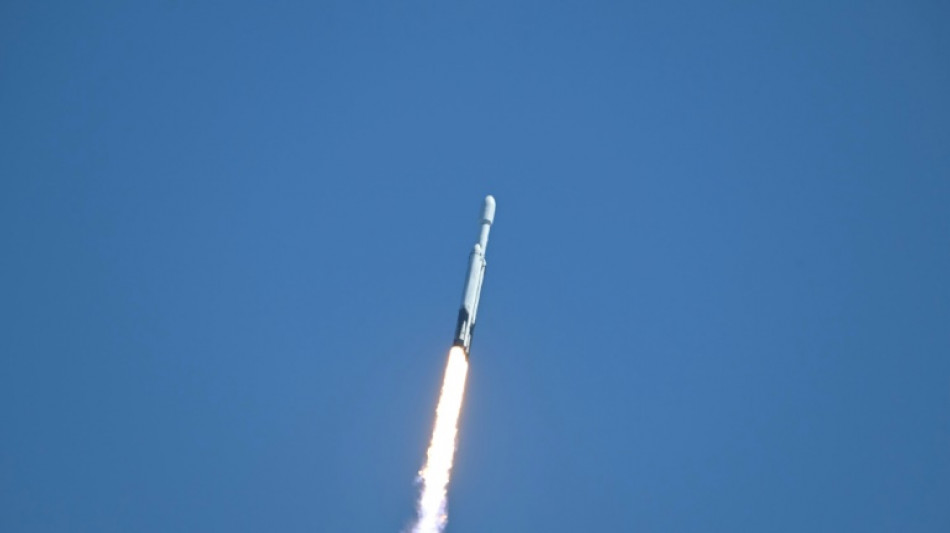
-
 Kenya's economy faces climate change risks: World Bank
Kenya's economy faces climate change risks: World Bank
-
World stocks mostly slide, consolidating Fed-fuelled gains

-
 Crypto firm Tether bids for Juventus, is quickly rebuffed
Crypto firm Tether bids for Juventus, is quickly rebuffed
-
UK's king shares 'good news' that cancer treatment will be reduced in 2026

-
 Can Venezuela survive US targeting its oil tankers?
Can Venezuela survive US targeting its oil tankers?
-
Salah admired from afar in his Egypt home village as club tensions swirl

-
 World stocks retrench, consolidating Fed-fuelled gains
World stocks retrench, consolidating Fed-fuelled gains
-
Iran frees child bride sentenced to death over husband's killing: activists

-
 World stocks consolidate Fed-fuelled gains
World stocks consolidate Fed-fuelled gains
-
France updates net-zero plan, with fossil fuel phaseout

-
 Stocks rally in wake of Fed rate cut
Stocks rally in wake of Fed rate cut
-
EU agrees recycled plastic targets for cars

-
 British porn star to be deported from Bali after small fine
British porn star to be deported from Bali after small fine
-
British porn star fined, faces imminent Bali deportation

-
 Spain opens doors to descendants of Franco-era exiles
Spain opens doors to descendants of Franco-era exiles
-
Indonesia floods were 'extinction level' for rare orangutans

-
 Thai teacher finds 'peace amidst chaos' painting bunker murals
Thai teacher finds 'peace amidst chaos' painting bunker murals
-
Japan bear victim's watch shows last movements

-
 South Korea exam chief quits over complaints of too-hard tests
South Korea exam chief quits over complaints of too-hard tests
-
French indie 'Clair Obscur' dominates Game Awards

-
 South Korea exam chief resigns after tests dubbed too hard
South Korea exam chief resigns after tests dubbed too hard
-
Asian markets track Wall St record after Fed cut

-
 Laughing about science more important than ever: Ig Nobel founder
Laughing about science more important than ever: Ig Nobel founder
-
Vaccines do not cause autism: WHO

-
 Crypto mogul Do Kwon sentenced to 15 years for fraud: US media
Crypto mogul Do Kwon sentenced to 15 years for fraud: US media
-
'In her prime': Rare blooming of palm trees in Rio

-
 Make your own Mickey Mouse clip - Disney embraces AI
Make your own Mickey Mouse clip - Disney embraces AI
-
OpenAI beefs up GPT models in AI race with Google

-
 Dark, wet, choppy: Machado's secret sea escape from Venezuela
Dark, wet, choppy: Machado's secret sea escape from Venezuela
-
Cyclone causes blackout, flight chaos in Brazil's Sao Paulo

-
 2024 Eurovision winner Nemo returns trophy over Israel's participation
2024 Eurovision winner Nemo returns trophy over Israel's participation
-
US bringing seized tanker to port, as Venezuela war threats build

-
 Make your own AI Mickey Mouse - Disney embraces new tech
Make your own AI Mickey Mouse - Disney embraces new tech
-
Time magazine names 'Architects of AI' as Person of the Year

-
 Floodworks on Athens 'oasis' a tough sell among locals
Floodworks on Athens 'oasis' a tough sell among locals
-
OpenAI, Disney to let fans create AI videos in landmark deal

-
 German growth forecasts slashed, Merz under pressure
German growth forecasts slashed, Merz under pressure
-
Thyssenkrupp pauses steel production at two sites citing Asian pressure

-
 ECB proposes simplifying rules for banks
ECB proposes simplifying rules for banks
-
Stocks mixed as US rate cut offset by Fed outlook, Oracle earnings

-
 Desert dunes beckon for Afghanistan's 4x4 fans
Desert dunes beckon for Afghanistan's 4x4 fans
-
Breakout star: teenage B-girl on mission to show China is cool

-
 Chocolate prices high before Christmas despite cocoa fall
Chocolate prices high before Christmas despite cocoa fall
-
Austria set to vote on headscarf ban in schools

-
 Asian traders cheer US rate cut but gains tempered by outlook
Asian traders cheer US rate cut but gains tempered by outlook
-
AI's $400 bn problem: Are chips getting old too fast?

-
 Oracle shares dive as revenue misses forecasts
Oracle shares dive as revenue misses forecasts
-
US stocks rise, dollar retreats as Fed tone less hawkish than feared

-
 Divided US Fed makes third straight rate cut, signals higher bar ahead
Divided US Fed makes third straight rate cut, signals higher bar ahead
-
Machado to come out of hiding after missing Nobel ceremony


NASA probe Europa Clipper lifts off for Jupiter's icy moon
NASA probe Europa Clipper lifted off from the US Kennedy Space Center on Monday, bound for an icy moon of Jupiter to discover whether it has the ingredients to support life.
Lift-off took place aboard SpaceX's powerful Falcon Heavy rocket. The probe is set to reach Europa, one of Jupiter's many moons, in five and a half years.
The mission will allow the US space agency to uncover new details about Europa, which scientists believe could hold an ocean beneath its iced-over surface.
"With Europa Clipper, we're not searching for life on Europa, but we're trying to see if this ocean world is habitable, and that means we're looking for the water," said NASA official Gina DiBraccio, ahead of the launch.
"We're looking for energy sources, and we're really looking for the chemistry there, so that we can understand what habitable environments might be throughout our whole universe," she added.
If life's ingredients are found, another mission would then have to make the journey to try and detect it.
"It's a chance for us to explore not a world that might have been habitable billions of years ago" like Mars, Europa Clipper program scientist Curt Niebur told reporters, "but a world that might be habitable today, right now."
The probe is the largest ever designed by NASA for interplanetary exploration.
Europa Clipper is 30 meters (98 feet) wide when its immense solar panels -- designed to capture the weak light that reaches Jupiter -- are fully extended.
- Primitive life? -
While Europa's existence has been known since 1610, the first close-up images were taken by the Voyager probes in 1979, which revealed mysterious reddish lines crisscrossing its surface.
The next probe to reach Jupiter's icy moon was NASA's Galileo probe in the 1990s, which found it was highly likely that the moon was home to an ocean.
This time, the Europa Clipper carries a host of sophisticated instruments, including cameras, a spectrograph, radar and a magnetometer to measure its magnetic forces.
The mission will look to determine the structure and composition of Europa's surface, its depth, and even the salinity of its ocean, as well as the way the two interact -- to find out, for example, if water rises to the surface in places.
The aim is to understand whether the three ingredients necessary for life are present: water, energy and certain chemical compounds.
If these conditions exist on Europa, life could be found in the ocean in the form of primitive bacteria, explained Bonnie Buratti, the mission's deputy project scientist.
But the bacteria would likely be too deep for the Europa Clipper to see.
- 49 flybys -
The probe will cover 2.9 billion kilometers (1.8 billion miles) during its journey, with arrival expected in April 2030.
The main mission will last another four years.
It will be subjected to intense radiation -- the equivalent of several million chest x-rays on each pass.
Some 4,000 people have been working on the $5.2 billion mission for around a decade.
NASA says the investment is justified by the importance of the data that will be collected.
If our solar system turns out to be home to two habitable worlds (Europa and Earth), "think of what that means when you extend that result to the billions and billions of other solar systems in this galaxy," said Niebur, the Europa Clipper program scientist.
"Setting aside the 'Is there life?' question on Europa, just the habitability question in and of itself opens up a huge new paradigm for searching for life in the galaxy," he added.
The Europa Clipper will operate at the same time as the European Space Agency's (ESA) Juice probe, which will study two other moons of Jupiter -- Ganymede and Callisto.
A.Leibowitz--CPN
